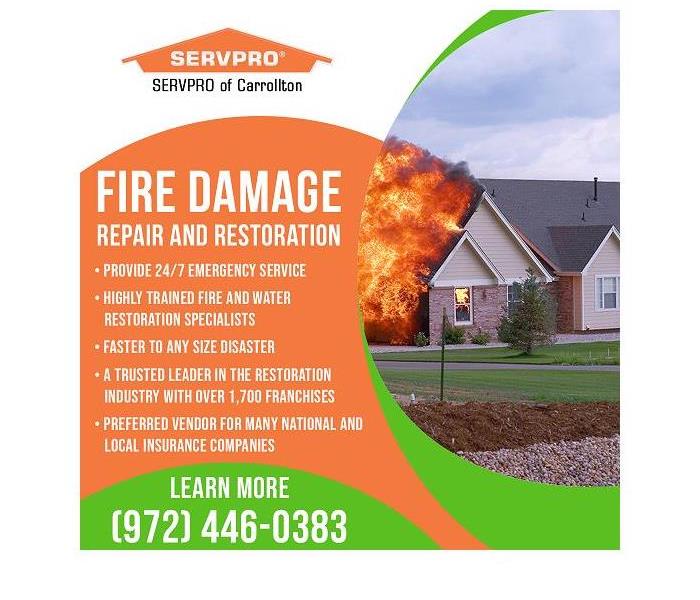How Proper Fire Safety Practices Can Prevent Wood Stove Fires
1/25/2021 (Permalink)
Blog Summary: SERVPRO of Carrollton shares wood stove fire safety tips that help prevent fire damage in the home.
This winter, SERVPRO of Carrollton is sharing wood stove fire safety tips to help homeowners stay safe and warm while minimizing the risk of fire damage. In their efforts to stay cozy this winter without breaking the bank, homeowners are supplementing their central heating system with alternative methods of heating, including fireplaces, pellet stoves, or wood stoves. The COVID-19 pandemic has sent tens of millions of workers and students home for the winter, increasing the need to keep the home warmer during the day. In past years, many homeowners would keep the temperature of the house much cooler when the house was unoccupied during the day. Now, many homes are occupied 24/7. By utilizing an alternate heat source such as a wood stove, remote workers and students can stay warm at an affordable cost.
Any alternative heat source requires regularly scheduled maintenance and upkeep for ongoing operation and continued safety. SERVPRO of Carrollton examines the types of wood stoves and shares wood stove fire safety tips to help homeowners stay safe and warm this winter.
Types of Wood Stoves
Because of their efficiency at producing heat, wood stoves are great supplemental heat sources, even better than most fireplaces. Wood stoves fall into the following two general categories: freestanding or a wood stove insert.
A wood stove insert fits in the fireplace opening and vents smoke, sparks, and excess heat through the chimney. Many models are equipped with an electric blower to circulate heat into the area around the stove.
A freestanding wood stove stands alone in a room and connects to the chimney through a chimney connector. Sometimes wood-burning stoves may share the flue of an existing fireplace. Other stoves may vent into a separate chimney constructed to handle the smoke, sparks, and excess heat from the stove.
Using the Wood Stove
Before using the wood stove, have the chimney inspected by a certified professional chimney sweep to determine if the existing chimney can be used with a wood stove. A wood stove generates intense heat and combustion gases. The chimney should be made from masonry and lined with flue tiles in good condition.
Freestanding wood stoves should be positioned as close to the chimney as possible. The reason is to limit the length of the flue pipe (or chimney connector). The flue may become very hot. When determining the location where the stove will be installed, make sure that both the stove and the chimney connector are easy to access for inspection and cleaning.
If purchasing a home that comes with a wood stove, an inspection is recommended to confirm the safety of the unit and venting system. A certified chimney sweep should be able to provide operating instructions for the stove model. Make sure the wood-burning stove conforms to modern performance and safety standards and is listed by Underwriters Laboratories or other reputable testing organizations.
A freestanding wood stove should be installed only on a fire-resistant surface or pad. Do not connect the vent to a chimney flue that also serves a furnace, boiler, or other wood stoves. Carbon monoxide poisoning or a fire could result.
Wood Stove Safety Tips
A wood stove can provide amazing comfort and savings. These wood stove fire safety tips will help prevent risks such as fire damage, burns, or carbon monoxide poisoning.
Tip #1. Keep children and pets away when a fire is burning in the stove. The stove’s exterior and flue pipe become very hot.
Tip #2. Keep combustibles at least three feet away from the stove.
Tip #3. Install and regularly maintain working carbon monoxide alarms and smoke alarms in the home. Locate smoke detectors and carbon monoxide detectors outside each bedroom and on every level of the home.
Tip #4. Remove ashes frequently. Properly dispose of them since ashes can take several days to completely cool. Place ashes in a covered metal container, and keep the ash container at least ten feet away from structures and vehicles.
Tip #5. Schedule an annual chimney and wood stove inspection with a certified chimney sweep who is competent to deal with wood stoves. Schedule another inspection halfway through the burning season to check for creosote buildup or defects that might have developed through the season.
Tip #6. Do not “over fire” the stove. Building a fire that exceeds the rating of the stove can result in flames entering the flue pipe or chimney, which can lead to a fire. Over firing the wood stove can damage the unit and create a fire hazard.
Tip #7. To avoid over firing, check the instruction manual or check with the manufacturer.
Tip #8. Only burn well-seasoned hardwoods in a wood stove. Coal, rubber, garbage, plastics, or other non-wood combustibles can damage a stove. Aerosol cans may explode or give off toxic, hazardous fumes.
A wood stove is a fantastic supplement to an existing HVAC system. Proper safety practices and regular maintenance will keep a home warm and comfortable throughout the winter season. In case of puff back, fire damage, or water damage from extinguishing a fire, SERVPRO of Carrollton can be on the scene in about an hour to begin the fire damage restoration, smoke damage restoration, or water damage restoration process. The team understands the stress caused by the disruption, chaos, and messes that come from a property damage disaster. SERVPRO of Carrollton will manage the entire cleanup and restoration process, including providing a free estimate and handling all insurance claims.
For more information about fire damage restoration in Carrollton, TX, contact the office by phone at (972) 446-0383 or by email at office@SERVPRO10952.com.





 24/7 Emergency Service
24/7 Emergency Service
